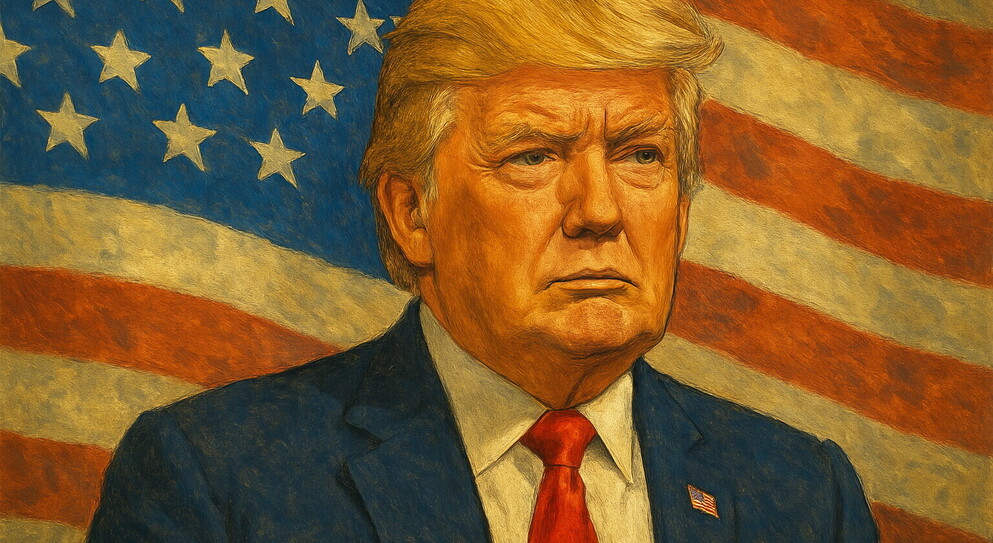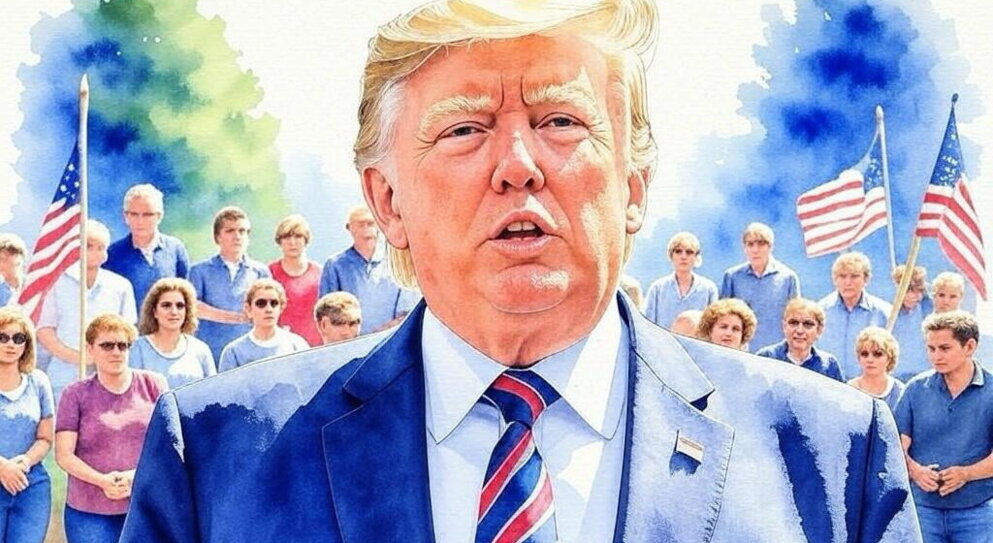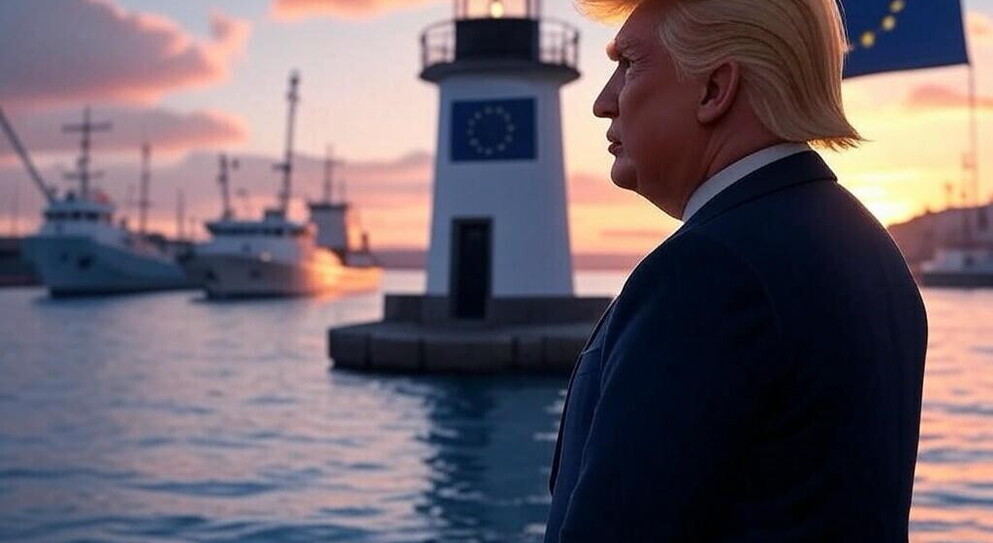Upon examining various articles in Il Foglio (the AI version), it becomes immediately apparent that American President Donald Trump features prominently, both in the content of the articles and in the accompanying imagery. A closer analysis of these images reveals a discernible pattern in how Trump is portrayed, suggesting that the selection of pictures is far from arbitrary. The following is a selection of images from the journal that highlights the recurring visual depiction of Trump from a specific, deliberate perspective.
Note: we analyzed Il Foglio AI with several articles, which you can find linked at the bottom of this page. But you can also read them alltogether in a nice Flipbook, which you can find here: https://eumove.it/speciale-il-foglio-ai/

1.The picture on the left, shows that Donald Trump is foregrounded and occupies the central position, immediately drawing the viewer’s attention and signifying his dominance within the visual frame. His direct gaze, serious and determined, functions as a demand gaze, engaging the viewer and establishing a confrontational or authoritative interaction. The low angle shot visually elevates Trump, reinforcing his powerful status and leadership role. The image is dominated by red and blue tones, evoking the American flag, which not only reinforces national identity but also aligns Trump with strong nationalist symbolism. Through these visual semiotic choices, the image constructs Trump as a commanding, patriotic figure, emblematic of power and American ideals.

2.In this image, Donald Trump is foregrounded and positioned at the centre, highlighting his prominence and authority within the scene. His direct, serious gaze creates a demand relationship with the viewer, projecting determination and leadership. In the background, a group of American people holding the national flag appear to follow him, visually reinforcing the idea that he is a leader supported by the nation. The dominant light blue tones create a calm yet powerful atmosphere, while the abundant light gives the image an almost idealised, heroic quality. These visual elements construct Trump as a strong, unifying figure, symbolising both leadership and national identity.

3.In the 3rd picture, Trump is placed prominently in the foreground, overlapping the lighthouse, symbolising his continued dominance in the global scene despite the shifting tides of international relations. His serious and steady pose, coupled with his profile view looking toward the horizon, conveys a sense of resolute determination. The fact that he is not facing the viewer but instead gazing outward suggests a forward-looking perspective, positioning Trump as someone who believes the future is firmly within his control. The lighthouse, featuring the European Union flag, stands in the background but is overshadowed by Trump’s figure. This contrast suggests that while Europe may represent stability and a new direction, it is still within the shadow of Trump’s influence, reflecting his role in shaping the future. The sea and boats in the background add to the metaphor of a turbulent geopolitical environment, with Trump being depicted as navigating these uncertain waters, while the EU flag on the lighthouse hints at the potential of Europe to offer a guiding light, albeit one that is yet to surpass Trump’s influence. Overall, the image shapes a narrative of Trump’s ongoing power, with the future still largely in his hands despite the rising prominence of Europe.
The three pictures featuring Donald Trump share several common visual features that reinforce his portrayal as a dominant and authoritative figure. In all three images, Trump is foregrounded and centrally positioned, drawing immediate attention and signifying his prominence. His serious, determined gaze is another consistent element, establishing a demand relationship with the viewer and emphasising his leadership qualities. The low-angle shots in two of the images further elevate his stature, visually reinforcing his powerful and commanding role. The use of patriotic symbols, such as the American flag in the first two pictures and the European Union flag on the lighthouse in the third, serves to situate Trump as a figure deeply connected to national identity and global influence. While the backgrounds vary, ranging from the American people supporting him in the second picture to the EU flag in the third, each image portrays Trump as a leader who exerts control over his environment, with the contrast between him and the background elements suggesting his dominant position in global affairs. Collectively, these visual choices convey the message that Trump remains a powerful, authoritative figure, with his influence and leadership still central, even in the face of rising global challenges, including the increasing prominence of Europe.
The portrayal of Donald Trump as a heroic figure in Il Foglio’s AI-generated content stands in stark contradiction to the director’s claim that the journal follows a distinctly pro-European editorial line. Trump’s presidency has been marked by open tensions with the European Union on several critical fronts. On security, he repeatedly undermined NATO by questioning its relevance and threatening to withdraw U.S. support unless European members increased their military spending, actions that directly challenged transatlantic cohesion. On trade, his administration imposed tariffs on European steel and aluminum and threatened additional duties on cars, sparking disputes with the EU and disrupting long-standing economic cooperation. Most notably, Trump’s ambivalent stance on Russia and the war in Ukraine—highlighted by his reluctance to condemn Russian aggression and his efforts to withhold military aid to Ukraine—stood in sharp contrast to the EU’s unified and vocal support for Ukrainian sovereignty. The decision of the AI to visually and rhetorically elevate such a polarising figure points to a degree of algorithmic autonomy. While trained on the journal’s existing editorial content, the AI appears capable of generating narratives that stray from the declared ideological line. This disconnect highlights the challenges of maintaining editorial coherence in AI-generated journalism, where content may reflect patterns or associations not fully aligned with institutional values, thus requiring a critical and cautious approach to both its production and interpretation.